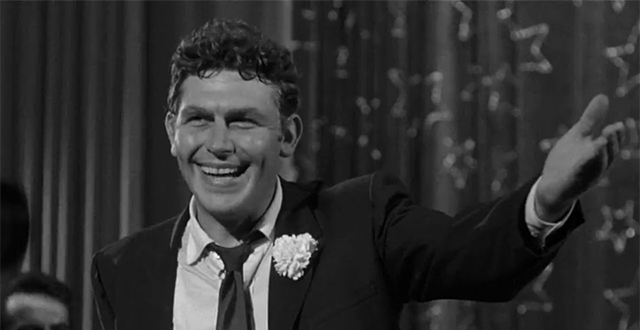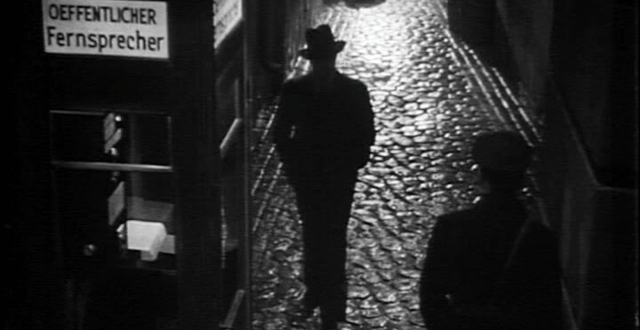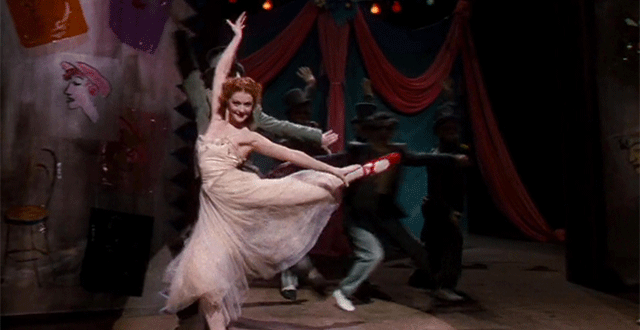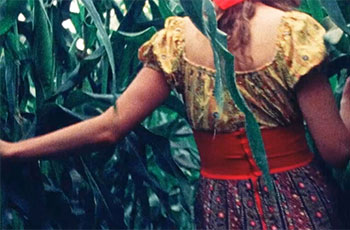News
Out of the Vaults: “A Face in the Crowd”, 1957
Meher Tatna
A Face in the Crowd was the film Steven Spielberg selected to present at the film restoration event for the HFPA’s 75th-anniversary celebrations at the Egyptian Theater in 2017. At our special screening, he called Elia Kazan’s film “way ahead of its time” in depicting our obsession with celebrity and power “with the nightmare scenario of an Arkansas drifter who turns folk hero who turns demagogue.” He continued: “The HFPA is passionately committed to the preservation of the art of cinema. As a Film Foundation board member and as one of its original founders, I want to express also on behalf of Mr. Scorsese back in New York, how grateful we are.”
Our partner, The Film Foundation, worked with the UCLA Film & Television Archive to restore the film back to its original glory. Extensively damaged sections in the original picture negative were replaced with new dupes made from a 1957 fine-grain master, and the main titles were restored to eliminate unsteadiness. The sound was digitally restored from an original 1957 mixed magnetic track and from a print of the film's original optical track. UCLA and The Film Foundation produced a fully timed 35mm final answer print and 35mm preservation fine-grain master positive. It was preserved in cooperation with Castle Hill Productions from the original 35mm acetate picture and soundtrack negatives and from master magnetic soundtrack materials.
Seen in the current era of celebrity worship, when the concept of fame for being famous and the intertwining of politics and entertainment have produced, among other things, the Trump presidency, Kazan’s film seems extraordinarily prescient. And being ahead of its time perhaps accounts for the fact it was not a huge success when it was released in 1957. After all, no one back then could have envisioned a businessman and reality TV host actually assuming the most powerful political office in the world. Even Kazan would have rejected this scenario for a movie as being too outlandish.
The movie is based on screenwriter Budd Schulberg’s short story Your Arkansas Traveler and is the second collaboration between him and Kazan after 1954’s On the Waterfront which won the Oscar for Best Picture. Patricia Neal plays Marcia Jeffries, a radio journalist who discovers a talented bum in an Arkansas jail and helps him get his own radio show. Andy Griffith, in his film debut, plays Lonesome Rhodes, the guitar-playing hayseed who goes on to such success on the radio that he segues into television and expands his fame and power with his aw-shucks charm and everyman persona. That persona conceals an ignorant but cunning and ambitious opportunist who takes advantage of his enormous influence to endorse a presidential candidate, Senator Worthington Fuller (Marshall Neilan). Fuller rapidly improves his standing with his ultra-rightwing agenda amplified by an increasingly out of control, arrogant Rhodes whom stardom has turned into a monster. When Marcia’s rose-colored glasses finally slip, she engineers Rhodes’ downfall. Anthony Franciosa plays his business manager; Walter Matthau is Marcia’s show writer. Lee Remick, in her screen debut, plays a cheerleader. Kazan filled out the cast with real-life media personalities like Mike Wallace, Bennett Cerf, John Cameron Swayze, Betty Furness, Sam Levenson, Virginia Graham, and Walter Winchell in cameo roles.
The poster for the movie reads breathlessly – “POWER! He loved it! He took it raw in big gulpfuls ... he liked the taste, the way it mixed with the bourbon and the gin in his blood!”
Through the movie, it was Kazan and Schulberg’s aim to critique the media and the public’s lionizing of celebrity and to show how the great unwashed fall for a charlatan’s lies. They particularly warned about unscrupulous persons using the power of television to manipulate the truth and delude the gullible.
In Kazan on Kazan by Michael Ciment, Kazan said of the film: “One of the points we wanted to make with the picture was the fantastic upward mobility in this country, the speed with which a man goes up and down. That we both knew well because we’d both been up and down a few times ... The thing that drove us was our belief in the theme, our anticipation of the power TV would have in the political life of the nation. ‘Listen to what the candidate says,’ we urged. ‘Don't be taken in by his charm or his trust-inspiring personality.’”The Lonesome Rhodes character was based partly on Will Rogers and Arthur Godfrey.
Marlon Brando was offered the principal role and turned it down. Griffith was discovered by Kazan after he heard his comedy monologue records that were broadcast on southern radio to wide popularity. “He was the real native American country boy and that comes over in the picture,” Kazan told Ciment. “I had him drunk all through the last big scene because it was the only way he could be violent – in life he wants to be friends with everybody.”
The Blytheville Courier News of August 8, 1956 talks about the biggest location shoot that took place in Poplar Bluff, Missouri, standing in for the fictional town of Piggott where the county fair and baton-twirling competition scenes were filmed. “Five thousand extras were sought, to be fed and paid $1 hourly for a mid-August day’s work. Sixty baton twirlers and musicians from six different high school bands were rounded up from Arkansas and Missouri. Remick reported spending two weeks in Piggott living with teen twirler Amanda Robinson and her family, working on her twirling and a local accent. Some of her baton-twirling scenes used a double. Some 380 dogs were assembled from Missouri and Arkansas for the scene following Rhodes’s first mass-action call on his audience: to take their dogs to the home of a local sheriff who was running for higher office to find out if a candidate is worthy of the office of dog catcher.”
The film was not that well-received upon release, critics being skeptical that television could have much impact on national politics. (It was only three years later that a sweating Richard Nixon lost a television debate, and the presidency, to John F. Kennedy.) One high-profile champion of the film at the time was François Truffaut who wrote in Cahiers du Cinema: “What is important is not its structure but its unassailable spirit, its power, and what I dare call its necessity. The usual fault with ‘honest’ films is their softness, timidity, and anesthetic neutrality. This film is passionate, exalted, fierce ... a great and beautiful work whose importance transcends the dimensions of a cinema review.”
A Face in the Crowd was selected for preservation in the United States National Film Registry by the Library of Congress as culturally, historically, or aesthetically significant in 2008.
COMMEMORATING 30 YEARS OF TFF
The animator and animation historian John Canemaker has referred to Oskar Fischinger as the Kandinsky of cinema. You could just as well call him its Klee or its Mondrian or its Hilma af Klint. Each of these artists was familiar with “alternative” spiritual disciplines like theosophy, anthroposophy and (in Fischinger’s case) Tibetan Buddhism and Hindu tantric rituals. And I think that they each felt their way to the spiritual through the practice of their art rather than visa versa. In a 1943 letter to his patroness (for a time) Hilla Rebay, one of the co-founders of the Guggenheim Museum, Fischinger wrote that in the late 20s he developed a “rotating cylinder, driven by a motor, day and night, all the time, to hold my denials and affirmations in steady motion-rotation,” only to learn many years later of the “existing parallel thoughts in my continuous rotating cylinders and the thousands-of-years-old [Buddhist] prayer wheel.”
The Film Foundation has helped to facilitate the restorations of four of Fischinger’s greatest paintings-in-motion: the three-screen Raumlichtkunst, finished in 1929 and restored by the Center for Visual Music with the participation of the National Film Preservation Foundation, and three films made after he and his family fled Nazi Germany and emigrated to Los Angeles in 1936, restored by the Academy. Allegretto, synchronized to Ralph Rainger’s piece “Radio Dynamics,” is a matter of staccato rhythms, suggesting the movement of criss-crossing impulses. Radio Dynamics, made in 1942, is silent, also a matter of rhythm but in this case the rhythm of emotions overlapping like waves, fields of color and texture ever expanding and converging, growing and overwhelming and nurturing and displacing one another endlessly. And Fischinger created Motion Painting No. 1 by filming every brushstroke of oil on plexiglass over 9 months: set to Bach’s 3rd Brandenburg Concerto, it’s a remarkable piece of work that keeps expanding in the mind, a constant crossing and re-crossing from outer to inner experience and back again. I could go on in multiple directions on Oskar Fischinger’s films, but I feel compelled to close with this: they could only have been made by hand, painstakingly, with actual paints and boards and animation stands and film, one mind-bending frame at a time.
- Kent Jones
Follow us on Facebook, Instagram, and Twitter!
RAUMLICHTKUNST (1926-29, d. Oskar Fischinger)
Preserved by the Center for Visual Music through the Avant-Garde Masters program funded by The Film Foundation and administered by the National Film Preservation Foundation.
ALLEGRETTO (1936, d. Oskar Fischinger)
Restored by the Academy Film Archive with finding provided by The Film Foundation.
RADIO DYNAMICS (1942, d. Oskar Fischinger)
Restored by the Academy Film Archive with finding provided by The Film Foundation.
MOTION PAINTING NO. 1 (1947, d. Oskar Fischinger)
Restored by the Academy Film Archive with finding provided by The Film Foundation.
COMMEMORATING 30 YEARS OF TFF
So Ends Our Night, directed by John Cromwell, is based on the 1939 novel Flotsam by Erich Maria Remarque. It was shot in 1940 and released by United Artists in early 1941. Like Christian Petzold’s recent Transit, it is about the particular plight of the refugee. What is it like to be stateless, wrenched away from everything familiar, permanently unsettled, and under the constant threat of absolute crushing force? Those are the questions that shadow every moment, every second, every frame. The characters played by Fredric March, Margaret Sullavan, a very young Glenn Ford, Leonid Kinskey (the bartender in a more famous refugee film, Casablanca) and Alexander Granach who meet up along the European trail of displaced persons, the trail taken by Arthur Koestler and Walter Benjamin, warm themselves with the elemental gifts of life: a roast chicken, a bottle of wine, laughter, and each other’s company. And every moment of camaraderie and good cheer is haunted by the memory of home and loved ones lost or scattered. The film builds to an extraordinary passage in which you can really feel the presence of production designer William Cameron Menzies. March’s character returns to Vienna and wants to say a fugitive goodbye to his wife, played by Frances Dee. They take alternate routes to a designated spot, turning corners and making their way through crowds, and the sequence reaches a visual and emotional crescendo as they each get one last look at each other in a breathless succession of close-ups before they part forever.
So Ends Our Night, which was restored by George Eastman House (and now needs further attention), was independently produced by David Loew and Albert Lewin. No major studio would have touched it at the time. Hollywood was painstakingly careful, to a point well beyond moral cowardice and until the last possible moment, to neither offend German audiences nor advocate for American intervention in Europe. Films like Confessions of a Nazi Spy (Warner Brothers) and The Mortal Storm (MGM) were extremely rare exceptions to the rule. So Ends our Night is a courageous film, and it’s sad to think that some of the people who made it would later face the horrors of the Red Scare (March was hounded by HUAC early on and Cromwell was blacklisted through most of the 50s). It’s also a film that moves me deeply because, like The Big Country, it manages a rare feat: to dramatize and truly embody the good in people.
- Kent Jones
Follow us on Facebook, Instagram, and Twitter!
SO ENDS OUR NIGHT (1941, d. John Cromwell)
Preserved by George Eastman Museum with funding provided by The Film Foundation.
THE BIG COUNTRY (1958, d. William Wyler)
Restored by Academy Film Archive with funding provided by The Film Foundation.
Out of the Vaults: "The Red Shoes", 1948
Meher Tatna
In 2017, the Hollywood Foreign Press Association asked Christopher Nolan to choose a film that the HFPA helped restore for a screening to celebrate our 75th anniversary. His choice was The Red Shoes. At his introduction of the film at the Egyptian Theater, he said, “The restoration of a film like The Red Shoes is only possible thanks to the pioneering work of organizations like the one set up by Marty.” He was referring to Martin Scorsese and the Film Foundation on whose board he serves. “You need money, you need support. And the HFPA has been one of the most important backers of his work for decades.”
It is no surprise that The Red Shoes was his choice. It is regarded as one of the best films of the partnership of Michael Powell and Emeric Pressburger who wrote, directed, and produced it. It was voted the ninth greatest British film of all time by the British Film Institute in 1999.
The restored version was first screened at the Cannes Film Festival in 2009 after three years of painstaking effort. Robert Gitt, Preservation Officer at the UCLA Film & Television Archive explained the process in a booklet distributed at the Cannes premiere.
Here’s how he described the shape of the film when he received it. “We were provided access to over two hundred reels of 35mm nitrate and acetate materials, including vintage Technicolor dye transfer prints, nitrate and acetate protection master positive copies, original soundtrack elements, and – most important of all – the still extant three-strip Technicolor camera negatives. For quality reasons, we chose these original negatives as our starting point even though they were afflicted with a daunting number of problems: 65% of the film had bad color fringing caused by differential shrinkage and sometimes by misadjustment of the camera during shooting; 176 shots contained color flickering, mottling and “breathing” because of uneven development and chemical staining; 70 sequences contained harsh optical effects with excessive contrast; and throughout there were thousands of visible red, blue and green specks caused by embedded dirt and scratches. Worst of all, mold had attacked every reel and begun to eat away the emulsion, leaving behind thousands of visible tiny cracks and fissures.”
579,000 individual frames were scanned directly from the three-strip camera negatives. Removal of the mold required the hand-cleaning of the negative frame by frame. The dirt and scratches had to be repaired, color correction and contrast issues had to be solved. The shrinkage had to be corrected so that it no longer looked like a 3-D movie without glasses. 4K resolution was employed at every stage of the digital picture restoration work, including the soundtrack, to remove “pops, thumps, crackles, and excessive background hiss.”
After watching the restored film, the New Yorker’s critic Anthony Lane wrote: “A blindingly rich and refulgent print ... you will not just be seeing an old film made new; you will have your vision restored.”
The story of the film is based on a Hans Christian Anderson fairy tale about a dancer who wears magic ballet shoes that force her to dance until she dies. Norma Shearer plays Victoria Page, a ballerina with the Ballet Lermontov. The company is run by Boris Lermontov, an autocratic impresario played by Anton Walbrook, a character based on Sergei Diaghilev of the Ballets Russes. Marius Goring is Julian Craster, a composer who has a romance with Victoria. Victoria finds her dedication to her art tested by her romance until she is forced to choose between love and career.
In 1948, when the film premiered, post-war films were primarily concerned with realism. Therefore, the heightened reality of the story was something that audiences rarely saw. Also, the film was filmed by cinematographer Jack Cardiff in spectacular Technicolor, and its visual beauty enhanced the heartbreak of Victoria’s yearning for her lover but still longing for her art. After all, when she was asked by Lermontov early in the film, “Why do you want to dance?” she answers, “Why do you want to live?” That answer comes back to bite her when Lermontov tells her later, “The dancer who relies on the comforts of human love will never be a great dancer. Never.” The sacrifices that artists make for their art is at the heart of the film.
The highlight of the film is a 17-minute dance sequence in which the Anderson tale is interwoven with the conflicted love story of the ballerina, and includes manifestations of hallucinations from the dancer’s splintered mind. It took six weeks to shoot.
Not only was it unheard of to break up the narrative of a film by such a long sequence, but the filmmakers also insisted on using a real ballet dancer for the lead role instead of a movie star. Shearer, from the Sadler’s Wells Ballet company, got the part. Powell and Pressburger were flying high after the success of Black Narcissus, so they pretty much had carte blanche to do what they wanted. However, the financers cut £10,000 out of their salaries as the budget ballooned from £300,000 to £500,000 as they were convinced the film would never make money. Powell wrote many years after, “Twenty years later, when The Red Shoes was one of the top-grossing box-office films of all time and was included in Variety’s ‘Golden Fifty,’ we were glad to have made the sacrifice.” The film received the Golden Globe for Best Score and the Oscar for Best Score and Best Art Direction. It made over $5 million at the box office, the first British film to ever do so.
In The Red Shoes Revisited, Adrienne L. McLean writes that Shearer declined the role at first, afraid it would hurt her ballet career. She quotes Shearer as saying: “Red Shoes was the last thing I wanted to do. I fought for a year to get away from that film, and I couldn't shake the director off.” After the success of the film, she gave up the ballet corps voluntarily in order to continue acting and had a successful Hollywood career.
The film premiered at the Bijou Theater in New York City in 1948, and ran for two years, earning $2.2 million in the US alone.
A Broadway adaptation based on the film opened in 1993 at the Gershwin Theater; it was directed by Stanley Donen with music by Jule Styne and book and lyrics by Marsha Norman. A ballet based on the film, choreographed by Matthew Bourne, opened in London in 2016.




